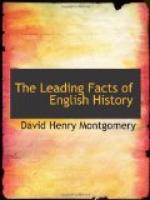In the reign of Anne, 1707, Scotland and England were united under the name of Great Britain. During her sovereignty the permanent Whig and Tory parties, which came into existence in the time of Charles II, became especially prominent. They have since continued to divide the parliamentary government between them,—the Whigs seeking to extend the power of the people; the Tories, that of the Crown and the Church. After the passage of the Reform Bill in 1832 (S582) the Whigs took the name of Liberals and the Tories that of Conservatives. The system of Cabinet Government, which now prevails, took its rise in 1721 under Robert Walpole, seven years after Anne’s death (S534).
II. Religion
518. Religious Parties and Religious Legislation.
At the beginning of this period we find four religious parties in England: (1) the Roman Catholics; (2) the Episcopalians, or supporters of the National Church of England; (3) the Puritans, who wised to remain members of that Church, but who sought to “purify” it from certain Roman Catholic customs and modes of worship; (4) the Independents, who were endeavoring to establish independent congregational societies. In Scotland the Puritans established their religion in a Church governed by elders, or presbyters, instead of bishops, which on that account got the name of Presbyterians.
James I persecuted all who dissented from the Church of England; and after the Gunpowder Plot the Roman Catholics were practically deprived of the protection of the law, and subject to terrible oppression. In James’s reign Bartholomew Legate, a Unitarian, was burned at West Smithfield Market, London (1612), for denying the doctrine of the trinity. He was the last English martyr. Charles I greatly exasperated the Puritans in the English Church by his Declaration of Sports, which recommended games in the churchyards after service on Sunday. Clergymen who refused to read the Declaration to their congregation were dismissed from their places.
During the period of the Civil War and the Commonwealth, Presbyterianism was established as the national worship of England and Scotland by the Solemn League and Covenant. A great many Episcopal clergymen were deprived of their parishes. At the Restoration several laws against the Scotch Covenanters and other Dissenters were enforced, and retaliatory legislation drove two thousand clergymen from their parishes to starve. On the other hand, the pretended Popish Plot caused the exclusion of Roman Catholics from both houses of Parliament, and all persons holding office were obliged to partake of the sacrament according to the Church of England. James II’s futile attempt to restore Catholicism ended in the Revolution and the passage of the Toleration Act, granting liberty of worship to all Protestant Trinitarians. Stringent laws were passed against Catholics (1700), but they were not regularly enforced. Under Anne the Occasional Conformity Act (1711) and the Schism Act (1714) were aimed at Dissenters. The first of these laws punished officeholders who, during their term of office, should attend any dissenting place of worship; the second forbade any person’s keeping a public or private school unless he was a member of the Church of England. Both laws were repealed a few years later (1718).




